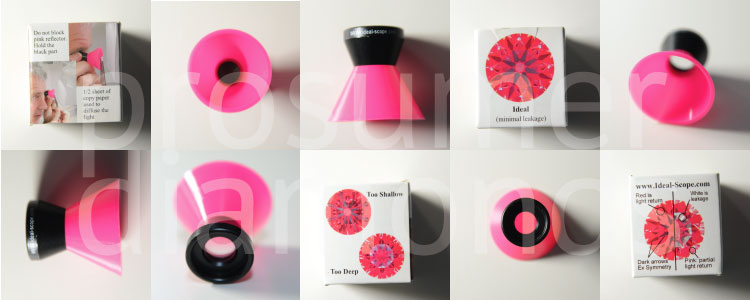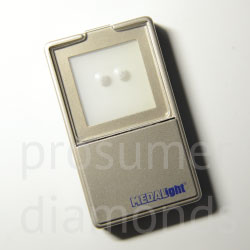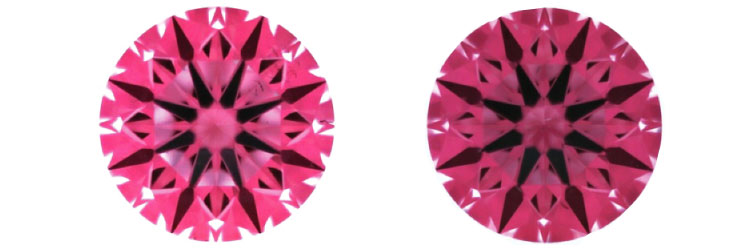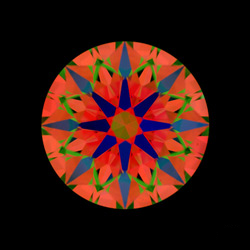Light Return
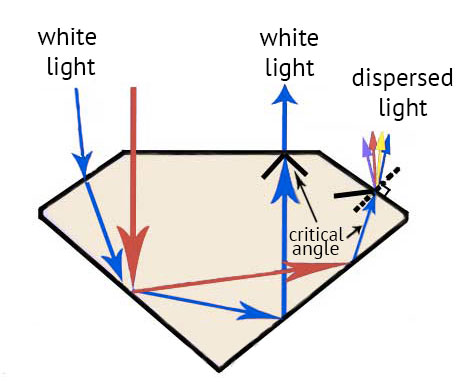
If the pavilion of the diamond is cut too shallow (<40.6-degrees) or too steep (>40.9-degrees), then instead of light returning from the top of the diamond, light will leak away from the bottom of the diamond. A diamond that returns light rather than having it leaked away will be a bright one.
Now let’s follow another ray of light (in red) that enters the diamond through the table of the diamond. Again, the ray of light is totally reflected off two pavilion mains. As it leaves the diamond through the crown, the crown acts like a prism. When white light hits a prism, it is dispersed into the colors of the rainbow. That is why we sometimes see colored-light being returned by a diamond, which we call fire.
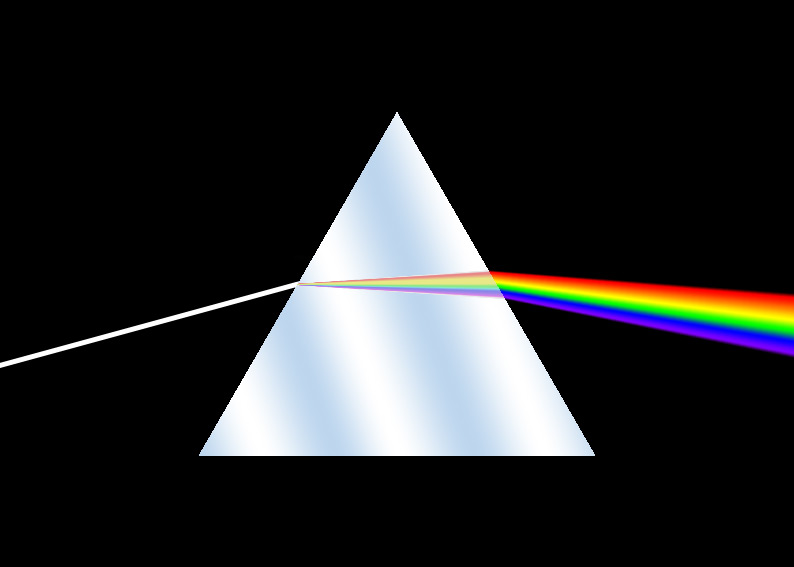
Whether you see white light or colored light in a diamond also very much depends on lighting. So you will naturally see white light in a diamond when you look at it under diffuse lighting such as indoor fluorescent lights. On the other hand, if you take the diamond and look at it under spot lights then you will see more fire.
Depending on how you choose the proportions of your diamond, there can be a trade-off between brightness and fire. I’ll be discussing this trade-off in more detail in a later tutorial, but what is important to understand right now is that light leakage is detrimental to both brightness and fire.
If light leakage is bad, are we looking for 100% light return? Not exactly.
A mirror is a device that returns 100% of the light shone on it, but we don’t pay thousands of dollars for mirrors or use them as jewelry. Our goal is therefore not maximizing light return but to ensure that light is returned in a way that gives excellent contrast. The facets in a diamond are designed to create what I call structured contrast. What I mean by this is that various levels of brightness are being returned to the observer so the diamond is interesting to look at.
Evaluating Light Performance
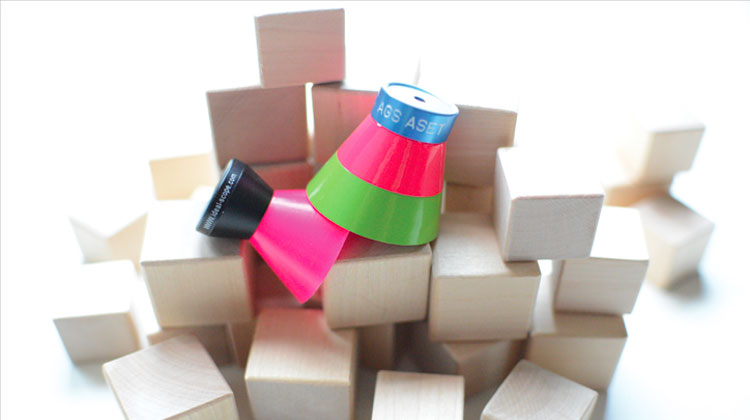
The Idealscope
The idealscope is a portable device invented by Gary Holloway that is made up of a 10x magnifying lens and a red reflector. It was originally designed for professionals to quickly reject parcels of diamonds. When used properly, the idealscope allows you to quickly determine whether there is light leakage in a diamond. However, you should be aware that despite being popular among online vendors, the idealscope is not a standard evaluation tool for the trade.
Since the idealscope and ASET are not sales tools, most stores won’t have them for you to use. There are a lot of poor performing diamonds that are being sold to uninformed consumers every day. In fact, the majority of diamonds that are in stores are those that you wouldn’t buy once you’ve assessed it with an idealscope.
So if you’re planning to buy a diamond from your local jewelry store, it’s a good idea to invest in either an idealscope or an ASET.
How to use an Idealscope
Even though the idealscope is simple to use once you know how, I’ve seen enough beginners use the idealscope for the first time to know that it’s not super intuitive. If you don’t use it right, you’re not going to get the right results.
To use the idealscope properly, the bottom of the idealscope should be aligned with the girdle of the diamond. The diamond is viewed through the lens at the top of the idealscope. It’s best if there is a light source directly behind the diamond.
If you hold the idealscope up to a bright light, the image you see will be blown out so the best way to view an idealscope is under an ideal-light.
The ideal-light was developed specifically for the idealscope. It’s a good thing to have if you ever wanted to take reproducible idealscope images yourself.
If you choose to hold the idealscope instead of using the ideal-light, Gary Holloway recommends holding it up against a desk lamp with a piece of paper in front of it. From my own tests, I have found that sticking a piece of facial tissue in front of a typical fluorescent desk lamp can give good results.
Assessing Idealscope Images
What you’re looking for in a well-cut diamond are dark arrows with the rest of the diamond being bright red or pink. The objective of using the idealscope is to compare the shades of red throughout a diamond. The actual shade of red is not as important as the relative saturation between the shades of red that can be seen in any given idealscope image. Don’t expect the same shade of red throughout the diamond, a diamond is designed to have varying intensity of light return to create a structured contrast in the diamond.
There are 3 things you can tell immediately from an idealscope image.
• Red indicating areas excellent light return
• Black indicating areas of light obstruction
• White indicating areas of light leakage
The image on the left has some light leakage around the edges of the diamond where the upper girdles are. This is what is expected in a classic ideal-cut diamond.
A cutting techniques known as ‘crown-only painting’ can improve the light return in these areas. The image on the right is an example of a diamond that has slight painting. More importantly, the idealscope image on the left indicates that this diamond has some light leakage under the table facet so we can quickly reject it.
In the slightly painted diamond, you can see areas of light and deep reds. Lighter reds indicate areas where there is weaker light return and deeper reds indicate areas where there is more intense light return.
Notice that the two idealscope images have different brightness. This is more to do with inconsistent photography than the diamonds themselves and is why you should only compare the relative reds that you see in each individual idealscope image.
Ideally, you want to see black arrows and triangles as these create the contrast pattern in the diamond. These areas are called ‘hotspots’ and can also appear near the base of the arrow shafts in diamonds with longer star and lower girdle facets. They’re called hotspots because these are the spots that return the largest flashes the diamond sparkles. I need to clarify that darker arrows does not necessarily mean that the diamond is better, and it can also indicate problems with light obstruction.
When you look at a diamond face up, hotspots return light from the area where your head and body obstructs the light falling onto the diamond. So when you look at a diamond and see the color of your shirt, or if you have dark hair and the arrows seem to look dark, this is because of the reflections from the hotspots.
A poorly cut diamond with light obstruction problems will have too much darkness visible in the diamond at normal viewing distances. This is something that is difficult to tell in an image unless you have a lot of experience evaluating images and understand how the camera was set up to take the picture.
The Angular Spectrum Evaluation Tool (ASET)
When we talk about light performance, we are also referring to where the diamond returns light from. In real life, most often you will be looking at the diamond while it’s on your finger with lights behind or above you. Studies have identified that ideally the diamond should return light from between 45 and 75-degrees as measured from the plane of the girdle, being the region around your shoulders. Below 45-degrees and the diamond is likely to pick up other light sources or color, and above 75-degrees is where the diamond will pick up the shadow of your head.
The ASET, a tool developed by the AGS, is a piece of reflector technology that works very much like the idealscope. Unlike the idealscope, an ASET image is designed to reveal the direction that a diamond is picking up light from and not to compare light intensities. If you look at a handheld ASET scope, you will see that its reflector has a three tier design.
• Blue indicates areas of light obstruction (Light is obstructed by your body between 75 – 90 degrees; 90 being vertical)
• Red indicates areas of intense light return (Light is returned from light sources that are behind you between 45 – 75 degrees)
• Green indicates areas of weak light return (Light is returned from the periphery between 0 and 45 degrees; 0 being horizontal)
The handheld ASET is an ASET 30, which means that it simulates 30 degrees of light obstruction. You may notice that sometimes two ASET images of the same diamond can look completely different. One reason is that vendors usually have access to the desktop version of the ASET that can be used to produce more consistent imagery and these images will look different to images taken through a handheld ASET. Another reason for discrepancies is that it is possible that the other image was taken using an ASET 40, which simulates an observer that is much closer to the diamond.
Also, if you’re comparing a photograph against a computer simulated image like the one on the AGS lab report, the difference is sometimes caused by scanning margins of error. Because of this, a properly taken photograph is always preferable to a simulated image. However, you should know that AGS cut grading is not solely based on a single ASET image. In fact, AGS bases their cut grade on the light performance of a diamond from many tilt angles.
The ASET should be used the same way as the idealscope, although the ASET seems to tolerate a stronger backlight better. What this tells us is that the ASET is not meant to evaluate light leakage. If you’re trying to take an ASET image, you should note that the idealscope has a magnified lens where the ASET doesn’t. You can read my tutorial on how to take idealscope and ASET images if you’re interested in taking them yourself.
Assessing ASET Images
Here’s the ASET image of a super-ideal diamond from Whiteflash. You can see that there is minimal green that is confined to the upper girdles of the diamond and in the reflection of the table. The green in the upper girdles indicates very slight painting. We saw how slight painting affected the idealscope image, so the ASET image is basically telling the same story in a different way.
One frequently asked question is why the center of a diamond is sometimes red and sometimes green in an ASET and whether a red center is preferable to a green center.
The center of the diamond is called a table reflection, because it is the reflection of the table facet. For any given diamond, depending on the pavilion angle, the table reflection can be red, green, or a mix of red and green on an ASET. For a 57% table, the table reflection turns green precisely when the pavilion angle is 40.768 degrees. Whether this matters or not depends on who you ask. Personally, I think that it’s not a big deal if a table reflection is green and AGS seems to agree because two-thirds of the diamonds in the AGS0 range are predicted to have a green table reflection face up.
Conclusion
Choosing a diamond with good light return is important, but it is equally important to ensure that most of the light being returned is from around your shoulders and not your head or the horizon. When optimizing for light performance, our aim is to minimize unwanted light leakage in a diamond. However, light performance is not about 100% light return, and contrast plays a large part in creating a beautiful diamond.
Two diamonds that have great light performance and optical symmetry can also look completely different because there are many different flavors of diamonds and there are often trade-offs to be made. So before you rush to buy a diamond with your new found knowledge, you should read the next tutorial where I will help you discover what your preferences are on the different characteristics that diamonds can have.
If you want some help evaluating your idealscope or ASET images, please get in touch with me and I will be happy to take a look for you.
